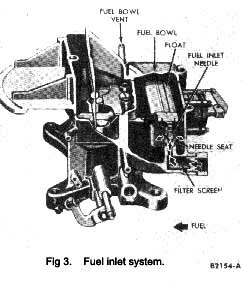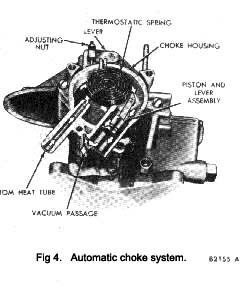Automatic Choke System
The choke plate, located in the air horn above the barrels, when closed, provides a high vacuum above as well as below the throttle plates. With a vacuum above the throttle plates, fuel will flow from the main fuel system as well as from the idle fuel system. This provides the extremely rich mixture necessary for cold engine operation.
The carburettor choke shaft is linked to a thermostatic choke control mechanism mounted on the main body (Fig. 4).
The linkage between the choke lever and the throttle shaft is designed so that the choke plate will partially open when the accelerator is fully depressed. This permits unloading of a flooded engine.
The automatic choke is equipped with a bi-metal thermo-static spring and a vacuum piston (Fig. 4). The bi-metal thermostatic spring mechanism winds up when cold and unwinds when warm. When the engine is cold, the thermostatic spring, through attaching linkage, holds the choke piston upward and the choke plate in a closed position prior to engine start. Manifold vacuum channelled through a passage in the choke control housing, draws the choke vacuum piston downward, exerting an opening force on the choke plate.
When the engine is started, manifold vacuum, acting directly on the piston located in the choke housing, Immediately moves the plate against the tension of the thermostatic spring to a partially open position to prevent stalling.
|
As the engine continues to operate, manifold vacuum draws heated air from the exhaust manifold heat chamber. The amount of air entering the choke housing is controlled by restrictions in the air passages in the carburettor. The warmed air enters the choke housing and heats the thermostatic spring causing it to unwind. The tension of the thermostatic spring gradually decreases as the temperature of the air from the heat chamber rises, allowing the choke plate to open. The air is exhausted into the Intake manifold.
When the engine reaches its normal operating tem-perature, the thermostatic spring exerts tension on the choke plate forcing it to the full open position. In this position, the choke piston is at its lowest point in the cylinder. Slots in the piston chamber wall allow sufficient air to bleed past the piston and into the Intake manifold, causing a continual flow of warm air to pass through the thermostatic spring housing. The spring thus remains heated and the choke plate remains fully open until the engine is stopped and allowed to cool.
The choke rod actuates the fast idle cam during choking. Steps on the edge of the fast idle cam contact the fast idle adjusting screw which permits a faster engine idle speed for smoother running when the engine is cold. As the choke plate is moved through its range of travel from the closed to the open position, the choke rod rotates the fast idle cam. Each step on the fast idle cam permits a slower idle r.p.m. as engine temperature rises and choking is reduced.
|
 **
**

